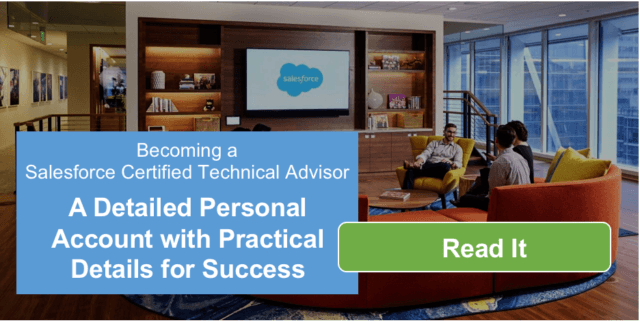#JourneyToCTA Solution Q&A

 Part 8 of Robert Wing’s personal
Part 8 of Robert Wing’s personal
#JourneyToCTA
Salesforce Certified Technical Advisor Test Q&A
After the presentation portion was a much needed 20-25-minute break. This provided a chance for water, restroom break and a snack.
I used this time to think back through what I had covered during the presentation and if there were points I wanted to particularly focus on correcting during the Q&A. The Facilitator explained that while I was doing my review, the judges were reviewing their notes to organize questions generally in the interest of my doing as well as possible on the test.
I was brought back into the room and the Q&A started. The questions followed a common cadence:
• Question starting specifically from a point in the scenario
• My answer
• Clarifying points, quite rapid and pointed
• Clear closure of that question and on to the next one from a different judge (this was my insistence on getting them to agree I’d answered the question or not)
When time ran out, I finished the answer to the open question. I could tell the judge wanted to follow up, but was cut short. The better answer he was looking for occurred to me on the elevator ride to the lobby; of course.
I found the Q&A portion of the Salesforce Certified Technical Advisor Q&A portion to have the feel of a constructive, if intense design review meeting. I didn’t get any of the harshness or “toughest hour in Salesforce” or other such things that other people have mentioned in their summaries of the test.
I found the judges to be courteous, professional, and with a very highly tuned attention to detail in confirming that I’d FULLY answered all the points in the scenario.
It seemed to be acceptable to acknowledge a mistake and correct- “the solution presented won’t work because ___; the correct solution is instead ___ because ___”. This seemed better than sticking to something wrong. In my case it was two solutions that worked fine on their own but didn’t work together.
When they adjusted the scenario a bit to explore a different area of knowledge (“how would you solve for X.X.X if you couldn’t use ___”) it seemed to be acceptable to quickly describe potential approaches then drive to a preferred option and why that one was preferred, as long as I didn’t bog down in pros-and-cons; they wanted an answer. It’s easier for me to think through it this way, and it seemed OK.
I found them to be helpful when asked (“did I answer your question?”) in explicitly answering either that I’d answered their question fully or that they weren’t satisfied yet and I should go either deeper or pay more attention to a different specific part of the scenario.
The judge’s questions were not at all leading. They did not ask questions like “why didn’t you use ___ for X.X.X” or “are you sure you don’t need another ___ to solve X.X.X”. They just asked for solutions to requirements points or pointed clarifications to them, but there was absolutely no leading to the answer they were looking for.
Time management was again an issue. We ran out of time way before they ran out of questions.
In Part 9, I revel preparation test strategies that worked, and those that did not on my #JourneyToCTA.
About Robert Wing, CTO, ArganoaMind Solutions
I’m a manager and architect focused on early-phase software product and project delivery. I focus on building the right things, building them correctly, and delivering them reliably.
As a partner in a ~100-person consulting and software business I do a bit of everything – marketing, negotiation & selling, estimation, planning, contracting, solution design, technical design, project management & governance, etc. – with a focus on being “the product guy” and “the details guy” amongst the partners.
